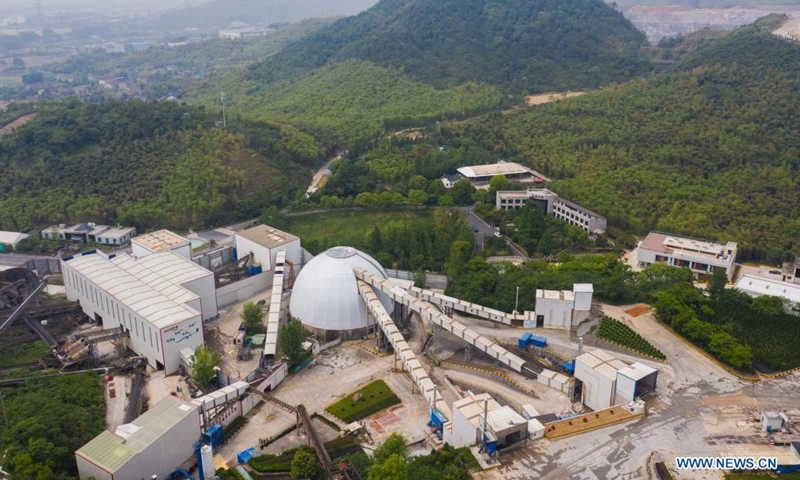
Aerial photo taken on May 8, 2021 shows leakproof workshops and conveyors at a construction material company in Donglin Township, Wuxing District of Huzhou City, east China's Zhejiang Province. Donglin Township has engaged all local residents in protecting the ecological environment by reducing pollutants such as floating dusts from the source.Photo:Xinhua
China has released a draft plan for cutting heavy metal emissions by 5 percent by 2025 from the 2020 levels through robust actions such as phasing out various outdated industrial capacities, a cautious but tough goal that, analysts say, underscores the country's resolve to meet its environmental protection goals despite challenges.
The plan, which was posted on the website of the Ministry of Ecology and Environment for public comment, said that China will take various steps to meet the goal, including phasing out obsolete and excess capacity that involves heavy metals.
Local governments are encouraged to impose even higher standards if they have the ability to do so, and capacity that can't meet environmental standards even after upgrading will be shut down, the document noted.
Moreover, regulators will keep a close eye on new construction or the expansion and renovation of existing projects, to make sure that the work complies with relevant environmental impact assessment requirements.
Key heavy metal pollutants on China's control and prevention list include lead and mercury. Major sectors that the regulators picked for management include the electroplating industry, the chemical products manufacturing industry and the leather tanning processing industry.
According to the document, China will speed up the transfer of professional electroplating companies in provinces like South China's Guangdong and East China's Jiangsu into special industrial parks. The goal is to shift 75 percent of those companies into parks by the end of 2025.
"As pollution controls on heavy metal in China continue to improve, the cost and difficulty of managing pollutants also increases. The goal to further cut heavy metal emissions shows the country's determination to further protect the environment and achieve its carbon peak and carbon neutrality targets," Ruan Qingyuan, technical director of the Beijing-based Institute of Public and Environmental Affairs, told the Global Times on Wednesday.
Industry analysts said that China set a somewhat cautious target of 5 percent, which shows that China has already made some progress in reducing pollution in this field.
"The 5 percent target is a little low compared with previous targets, but it shows that China has made some achievements in fighting heavy metal pollution, as the process will become more difficult when it approaches the end," Lin Boqiang, director of the China Center for Energy Economics Research at Xiamen University, told the Global Times on Wednesday.
Lin said that China's level of heavy metal pollution has been higher than in many developed countries, but lower than most developing countries, as China has made continuous efforts to adjust its industrial structure.
According to data released by the Ministry of Ecology and Environment, China's emissions of heavy metals in waste water decreased from 167.8 tons in 2016 to 120.7 tons in 2019, down 28 percent.
Ruan said that China has learned from other countries to strengthen its prevention and control of heavy metal pollution.
"Due to the different industrial structures of each province in China, some industries have larger emissions, including non-ferrous metals in East China's Jiangxi Province, and electroplating and leather industries in North China's Hebei and East China's Zhejiang," Ruan said.
Experts also noted that the cautious goals reflect the challenges of such work, as officials seek to balance environmental protection requirements and surging industrial demand.
According to independent industrial analyst Wu Chenhui, certain areas in China are heavily dependent on industries that can produce large volumes of heavy metal pollutants, such as Southwest China's Sichuan Province's reliance on polycrystalline silicon industries, and local governments might find it hard to meet environmental protection and development targets at the same time.
"Besides, demand for some polluting products are surging in these days, such as for polycrystalline silicon with the rise of photovoltaic power generation. This makes the work of heavy metal pollution management harder," Wu told the Global Times on Wednesday.
Ruan noted that heavy metals are mainly discharged through waste water, which is not easy to detect. Moreover, China's heavy metals generally have a lower concentration, so the authorities will have a higher demand for monitoring equipment.




